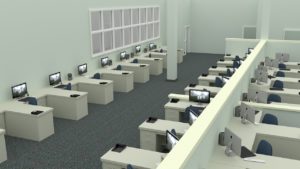Hot desk anxiety is one of the most searched for terms when browsing about hot desking. With the rise of WeWork, Hubble and other flexible working environments that operate on a hot desking basis, the nervousness around the trend has led people to question the advantages and disadvantages of hot desking.
 According to Open Sourced Workplace, “When it comes to hot-desking, the main reasons that are causing anxiety are the idea of not knowing where the employee will sit for the day, the time spent in setting up the computer, then if the surroundings of the day will match the needs of the tasks, not being able to communicate with the team, and not having personal space.”
According to Open Sourced Workplace, “When it comes to hot-desking, the main reasons that are causing anxiety are the idea of not knowing where the employee will sit for the day, the time spent in setting up the computer, then if the surroundings of the day will match the needs of the tasks, not being able to communicate with the team, and not having personal space.”
Hot desking advantages
- The cost-effective nature of hot-desking is one of the main reasons for its introduction. Before they were introduced, desks were often left empty by absent employees, making the workspace obsolete. In a hot-desk office, no desk is left empty.
- Employees feel empowered regardless of their position in the office. Not having a set desk allows employees to position themselves where they feel comfortable working, increasing productivity.
- The literal breaking down of walls reflects the figurative. A hot-desk office is open plan and breaks down barriers between colleagues who wouldn’t normally interact, producing a more collaborative workspace.
Hot desking disadvantages
- Change can be daunting so the prospect of arriving into work and not being able to find a desk can be unsettling for employees. The process is time-consuming, and time spent finding a desk could be spent better elsewhere.
- With ‘your’ desk not being your own it’s hard to make it personal. It can be difficult to be motivated in a space that you feel you’re not in control of
- Although hot desking opens up the office space and supposedly encourages colleague collaboration, employees often find themselves separated from the people they work with, making the open plan set up less productive.
A hot desking case study, brought to you by Adrian Burden
We interviewed a couple of experts to discuss this, alongside case studies, flexible working and more.
What is Wyche Innovation Centre and why did you create it?
“The Wyche Innovation Centre is a business centre designed to facilitate and promote entrepreneurship and the successful growth of SMEs. It is unusually situated in a rural setting in an Area of Outstanding Natural Beauty on the western slopes of the Malvern Hills. The town of Great Malvern has a heritage of business and technology innovation, but there was a real shortage of start up space for small but growing businesses.
“We wanted a place to base our own growing technology consulting business, and so we thought it would be good to be part of a buzzing community which we set out to create. When we first acquired the property, numerous people told us we were unwise because we were in a deep recession and the commercial rental market was poor. But our limited research indicated there was an appetite for affordable desk space for micro companies. Today the Wyche Innovation Centre is home to over 50 organisations; some in furnished offices, some at hot desks and others using the Centre for meetings and as a business address. Although we have generally had some capacity in our hot-desk zone, our office units have always been occupied.”
How do your virtual offices work?
 “The virtual offices are essentially an address service so that small businesses can benefit from a prestigious address without compromising the privacy of their own home. However, we can also handle courier deliveries and mail forwarding, as well as telephone answering services and office admin services such as filing, bookkeeping or general administration. Because we also have an on-site cafe and boardroom, virtual office users can benefit from using the address as a meeting location should clients need to visit. However, by being virtual the costs remain affordable and services can be paid for as needed. This arrangement suits entrepreneurs working from home or travelling extensively on business.”
“The virtual offices are essentially an address service so that small businesses can benefit from a prestigious address without compromising the privacy of their own home. However, we can also handle courier deliveries and mail forwarding, as well as telephone answering services and office admin services such as filing, bookkeeping or general administration. Because we also have an on-site cafe and boardroom, virtual office users can benefit from using the address as a meeting location should clients need to visit. However, by being virtual the costs remain affordable and services can be paid for as needed. This arrangement suits entrepreneurs working from home or travelling extensively on business.”
What technology is required for hot-desking?
“Our hot-desk facility provides flexible desk space for business users to work from on an occasional or permanent basis. It also provides a valuable pipeline for our office units. We use the RFID locking system to provide access to the facility, enabling us to issue key cards easily for new or temporary users. A key requirement is high speed Internet access which we offer via Wifi or through Internet cables at each desk. The bandwidth is likely to be better than most users can obtain from home, so they can work easily with large files and email attachments. We also offer shared multifunction printer and selected a model that supports user accounts so that we can charge back for printing.”
What are the challenges of managing a hot-desk office?
“Hot-deskers tend to be more transitory either because they like to try it out, have a temporary issue at home (school holidays, broadband outage or house redecoration) or are between jobs and testing the water at being an entrepreneur. This means we need to cost effectively manage the induction of new users and be prepared for a higher rate of turnover compared to the offices. As such, the challenge is to make the process as efficient as possible and ensure the users benefit from even a short period of use. We also have to think creatively about marketing the hot desk facility, as keeping a good level of occupancy can be a challenge if companies grow and move on. For example, we have recently signed up with NearDesk that helps market the facility nationwide, and we try to make people aware of the hot-desks when they attend business events at the Centre.”
4 Types of Space: Silent, Semi-silent, Collaborative and Common, brought to you by Wendy Clark
The Volvo Group are moving towards some big changes from their current way of working. The group are traditionalists and love to have their status offices with their teams sitting outside. However we are seeing an increase of staff rarely sitting at their allocated desk during the working day.
Conducting desk usage in some of the big sales and back office areas we are seeing 45% utilisation with meeting room usage increasing, especially small rooms for individual use.
I have had the privilege to be included as part of the Volvo Future Workplace project where we have produced a complete workbook describing how we want to design, develop and use our workspace going forward. It has been agreed that it is important that we keep the Volvo heritage in mind when creating a new workspace. We have developed 13 ‘Task’ areas split into 4 types of space, silent, semi-silent, collaborative and common with the look and feel of all the areas identified within each description.
One of my roles within the group is as Service Specialist in Workplace Efficiency for Western Europe, my project role will be as advisor to any new projects that will incorporate the Future Workplace way of working. Unfortunately WED has not been identified yet as one of the first to use this new concept so I am looking forward to when this will happen. There are several buildings that are currently undergoing this transformation around the globe and we are all waiting with baited breath to see how it is going to be accepted by the Volvo Group staff.
Advance your career in health and safety
Browse hundreds of jobs in health and safety, brought to you by SHP4Jobs, and take your next steps as a consultant, health and safety officer, environmental advisor, health and wellbeing manager and more.
Or, if you’re a recruiter, post jobs and use our database to discover the most qualified candidates.


